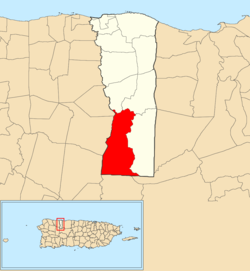Bayaney is a rural barrio in the municipality of Hatillo, Puerto Rico. Its population in 2010 was 3,550.[3][4][5]
Bayaney | |
|---|---|
Barrio | |
 Rock wall at entrance to Bayaney | |
 Location of Bayaney within the municipality of Hatillo shown in red | |
| Coordinates: 18°21′09″N 66°48′24″W / 18.35263°N 66.806717°W[1] | |
| Commonwealth | |
| Municipality | |
| Area | |
• Total | 7.78 sq mi (20.2 km2) |
| • Land | 7.78 sq mi (20.2 km2) |
| • Water | 0 sq mi (0 km2) |
| Elevation | 1,083 ft (330 m) |
| Population (2010) | |
• Total | 3,550 |
| • Density | 456.3/sq mi (176.2/km2) |
| Source: 2010 Census | |
| Time zone | UTC−4 (AST) |
| Census | Pop. | Note | %± |
|---|---|---|---|
| 1900 | 1,394 | — | |
| 1910 | 1,547 | 11.0% | |
| 1920 | 2,603 | 68.3% | |
| 1930 | 2,883 | 10.8% | |
| 1940 | 3,063 | 6.2% | |
| 1950 | 3,542 | 15.6% | |
| 1960 | 2,709 | −23.5% | |
| 1970 | 2,068 | −23.7% | |
| 1980 | 2,382 | 15.2% | |
| 1990 | 2,840 | 19.2% | |
| 2000 | 3,373 | 18.8% | |
| 2010 | 3,550 | 5.2% | |
| U.S. Decennial Census 1899 (shown as 1900)[6] 1910-1930[7] 1930-1950[8] 1980-2000[9] 2010[10] | |||
Description
editPuerto Rico Highway 487 travels through Bayaney.
History
editBayaney was in Spain's gazetteers[11] until Puerto Rico was ceded by Spain in the aftermath of the Spanish–American War under the terms of the Treaty of Paris of 1898 and became an unincorporated territory of the United States. In 1899, the United States Department of War conducted a census of Puerto Rico finding that the population of Bayaney barrio was 1,394.[12]
Gallery
editHomes and street as one is traveling south to north on PR-487 in Bayaney:
See also
editReferences
edit- ^ a b "US Gazetteer 2019". US Census. US Government.
- ^ U.S. Geological Survey Geographic Names Information System: Bayaney barrio
- ^ Picó, Rafael; Buitrago de Santiago, Zayda; Berrios, Hector H. Nueva geografía de Puerto Rico: física, económica, y social, por Rafael Picó. Con la colaboración de Zayda Buitrago de Santiago y Héctor H. Berrios. San Juan Editorial Universitaria, Universidad de Puerto Rico,1969.
- ^ Gwillim Law (20 May 2015). Administrative Subdivisions of Countries: A Comprehensive World Reference, 1900 through 1998. McFarland. p. 300. ISBN 978-1-4766-0447-3. Retrieved 25 December 2018.
- ^ Puerto Rico: 2010 Population and Housing Unit Counts.pdf (PDF). U.S. Dept. of Commerce, Economics and Statistics Administration, U.S. Census Bureau. 2010.
- ^ "Report of the Census of Porto Rico 1899". War Department Office Director Census of Porto Rico. Archived from the original on July 16, 2017. Retrieved September 21, 2017.
- ^ "Table 3-Population of Municipalities: 1930 1920 and 1910" (PDF). United States Census Bureau. Archived (PDF) from the original on August 17, 2017. Retrieved September 21, 2017.
- ^ "Table 4-Area and Population of Municipalities Urban and Rural: 1930 to 1950" (PDF). United States Census Bureau. Archived (PDF) from the original on August 30, 2015. Retrieved September 21, 2014.
- ^ "Table 2 Population and Housing Units: 1960 to 2000" (PDF). United States Census Bureau. Archived (PDF) from the original on July 24, 2017. Retrieved September 21, 2017.
- ^ Puerto Rico: 2010 Population and Housing Unit Counts.pdf (PDF). U.S. Dept. of Commerce Economics and Statistics Administration U.S. Census Bureau. 2010. Archived (PDF) from the original on 2017-02-20. Retrieved 2019-08-02.
- ^ "Anuario del comercio, de la industria, de la magistratura y de la administración. 1881". Biblioteca Nacional de España (in Spanish). p. 1614. Retrieved 4 April 2023.
- ^ Joseph Prentiss Sanger; Henry Gannett; Walter Francis Willcox (1900). Informe sobre el censo de Puerto Rico, 1899, United States. War Dept. Porto Rico Census Office (in Spanish). Imprenta del gobierno. p. 158.
External links
edit
